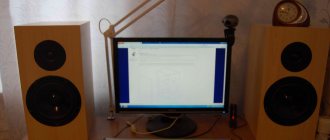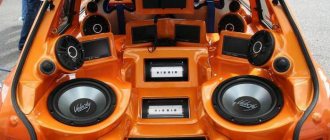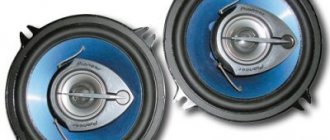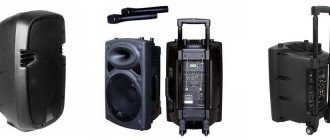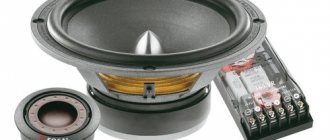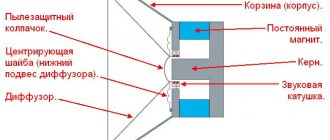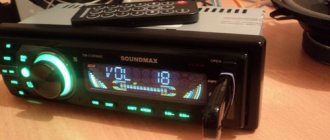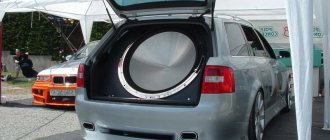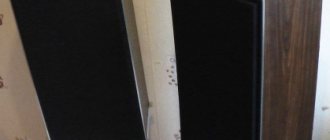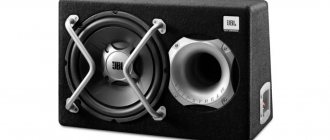Noema 50GDN-37 Do-it-yourself two-way acoustics.
Our Siberian answer to Western sanctions. I wanted to select the “portable speakers” section, but I stopped - it’s not the first of April yet. After the next, or extraordinary collapse of the ruble in 2022, and the sustainable development (and negative development is also development) of our economy, (for the first time in 15 years after 75GDSH-3- 3) I was forced to start looking around at Russian speaker production to make acoustics for my modest apartment. During this time, I was able to work with the truly outstanding TAD1102 speakers and the no less legendary Telefunken Red nipple and very pleasant BEAG HX301. It was always possible to get very pleasant bass and, what is very important, very legible and detailed midbass from one 12-inch speaker. The horn MF-HF unit is on top and you get a very interesting two-way band. Unfortunately, nowadays, with the current dollar exchange rate, it has become very difficult to buy a pair of good imported speakers. It is very good that NOEMA does not stand still and has released a very interesting speaker 50GDN-37. Let’s take a closer look at what this speaker is.
This is a typical mid-bass speaker made in the best traditions of the old school of the 60-70s such as Goodmans, TAD and others like them - a very light moving system - the mass of the moving unit assembled with a coil, central noise and suspension is about 33 grams. Resonant frequency 35 hertz and total quality factor 0.34. It was no coincidence that I immediately remembered TAD1102 - the T/C parameters are very similar. The only problem with such speakers is the large equivalent volume - the price to pay for the soft suspension and low resonant frequency coupled with slight movement. However, unlike the same BIG 301 (in some samples Qts 0.45), the power of the motor here and, as a result, the hollow quality factor of 0.34 allows you to use both FI and make the box smaller than the equivalent volume. BL almost 12 for mms 37grams.... New cast basket for standard size 12 inches compared to 75GDSH (which is actually 13 inches), coil ventilation - holes under the centering washer and a very aesthetic appearance. They even put a set of blades on the traditional NOEM connectors))). Or you can solder it using HindOvski)))). This Siberian RED WOOFER ©))) looks really nice. The reel frame is also “old school” - paper.
We measure the parameters of the till-small (although there is a factory paper, but we trust and check) Such parameters allow a relatively flexible approach to the size of the FI box. If you want a lower frequency response, the classic is 200. Of course, 200 liters is a lot for a home box. The minimum you can do is about 110 liters. The F3 bass will be around 45Hz, very sharp and punchy... File: 50GDN37.bb6 - Driver Properties Name: Type: Standard one-way driver No. of Drivers = 1 Fs = 35, Hz Qms = 9.86 Vas = 222, liters Cms = 0.559 mm/N Mms = 37, g Rms = 0.825 kg/s Xmax = 6, mm Xmech = 9, mm P-Dia = 259.5 mm Sd = 528.8 sq.cm P-Vd = 0.317 liters Qes = 0.36 Re = 5.5 ohms Le = 0.95 mH Z = 6.6 ohms BL = 11.15 Tm Pe = 50 , watts Qts = 0.347 no = 2.549% 1-W SPL = 96.21 dB 2.83-V SPL = 97.84 dB
Name: Type: Vented Box Shape: Prism, square (optimum) Vb = 109.3 liters Fb = 40, Hz QL = 6.38 F3 = 50, Hz Fill = normal No. of Vents = 2 Vent shape = round Vent ends = one flush Dv = 160, mm Lv = 501.9 mm
In theory, the croakers on the impedance should be leveled by setting the FI, but purely subjectively, I like to prop up the left hump a little higher - the bass turns out to be tastier or something))) this is pure subjectivity. BUT in this version we have 45 hertz. The diameter of the ports is not accidental - JBL advised that the port diameter should be at least 60 percent of the effective area of the emitting surface of the woofer. And in reality, all this interacts very strongly with the room - it seems that according to measurements from small FIs, there is bass, but the room interacts differently. Therefore, IMHO, a large port with such speakers is better, despite the greater inertia of the entire system compared to small FI ports. And YES - the speaker sensitivity is about 96 dB per watt... you can use it with a tube amplifier at home and there will be even more bass.
Here to each his own. Now we are trying to make a practical model from the theoretical model in a 120 liter box, measure the frequency response and simulate the filter. Height 600, width 500 and depth 450 mm, with port FI = 80 percent of the area of the radiating membrane of the speaker. The total volume of 144 liters is the price for a relatively low bass/light moving system and high sensitivity. The frequency response is about 40 cm from a box with a 60x60 cm face in a cage of 5 dB and not 10 like most companies.
Such an frequency response without sharp resonant bursts is quite simple for constructing a second-order filter. It’s not by chance that I’ll try the 1500-2500 hertz section – more precisely, how it turns out in reality. Above (and the narrowing of the pattern begins at 1400 Hz with approximately the given dimensions of the diffuser), the narrowing of the radiation pattern will already be very noticeable. Below, we break down the phase-time component in the system by separating the centers of radiation at these frequencies. Above 2000 hertz, a person cannot determine the apparent source by the difference in the time of arrival of the signal - the intensity component of the binaural effect works there))) but let’s not talk about binaural stereophonicity :)) now. The main thing is 300-2000 hertz from one point source.
Now it's time for the RF driver. There are a lot of drivers that play from 2000 hertz with a sensitivity of 96+. Subjectively, I like HF drivers either old school with a phenolic diaphragm or fashionable modern titanium / aluminum with a soft plastic suspension such as Celestion CDX1-1425, Radian 465pb or with them. Of course I like the TAD TD4002 except for the price. actually my ideal
BUT in my version, the contender for the HF link is the Radian 450 PB speaker in a wooden horn.
And the very first measurements of a high-frequency speaker in a wooden horn. The horn unit is installed on the lid of the FI prototype box with 50GDN37. Measurements from 40 cm as well as midbass.
From 1400 hertz you can safely start it IMHO. But let’s wait and listen and decide. There's a lot of room to maneuver. 1300 -2500 hertz can be experimented by ear with an equal frequency response. The wooden horn itself is positioned at 800... but it’s somehow scary to let the section go so low.
And the first filter simulation. The picture is very beautiful, but the 1000 hertz section is already critical for stereophony. TAD is boldly divided into 650 and 950 hertz and 1200 complexes and without a twinge of conscience. Of course, we’ll try this way and that.
The first prototype of a bookshelf speaker with a sensitivity of about 96 dB per watt is ready. Shelves made of 23mm plywood... the hardest thing is to cut them into one. Weight is about 50 kilograms of one column.
I’ll write separately about the amplifier-processor part if there is any interest.
This setup allows you to make delays channel by channel and adjust the frequency response by microphone for each channel and adjust the volume on the ADAU1467 processor.
Project in Sigmastudio from Analog devices.
Next, almost in Odessa, I begin to choose the crossover frequency by ear - when the lower classes can’t and the highs don’t want to))) I run, listen and play with a crossover from 1000 to 3000 and stop around 1500 hertz, dividing the filters by 100 hertz.
I insert an equalization block and level the frequency response in the listening area with the high-frequency and mid-range sections.
Radian without correction plays just perfectly in a wooden horn. After rough tuning by ear, I take all measurements in the listening area.
Well, as a result of experiments and equalization, it turned out at the listening location. This is in a room of 16 square meters with virtually no sound absorption. At the listening location, the total frequency response. Total with AC. The acoustics are spaced 4 meters apart. Each speaker is adjusted separately per channel. The listening position is about 3 meters. Experimentally, I delayed the HF link by 10 ms delay.
I no longer want to add more filters to equalize the sound. The bass really fills the room))) there are no wild peaks that are resonant. Horn HF gives a smooth picture at the listening position without reflections from the floor and ceiling. All that remains is to clean up the appearance. And of course I’ll stick the volume control knob into the chipboard. I won’t describe how it “plays”. I don’t like “Juicy and velvety smoke over percussion.” But the very good DAVIS KVK130 with a modified filter, playing from a Hypex nCore clone and a completely non-Chinese DAC on the AD1853 are already a thing of the past.
Why ask this review? Well, to show that something else is being produced in Russia and that not all radio amateurs assemble micro speakers from ready-made Chinese modules without measuring the frequency response and according to ready-made drawings. By the way, the amplifier is also entirely assembled on Russian-made modules, but that’s a completely different story. And that this world of homemade radio amateurs has not completely disappeared.
History of the Noema company
CJSC Noema is one of the oldest enterprises in Novosibirsk, founded back in 1929. Today the company is known to everyone as a manufacturer of dynamic drivers for professional and household acoustics, but since its founding it has gone through quite a few changes.
From the street
The company was founded on December 29, 1929 and its core business is sound and music. From 1929 to 1931, Noema produced stringed instruments such as balalaikas, guitars, and mandolins. From 1932 to 1940, the production of button accordions and accordions was mastered. During the Great Patriotic War, from 1941 to 1945, Noema was repurposed to produce skis for the front, shell boxes and accessories for military equipment.
After the end of the war, life demanded more instruments, people wanted music and joy, and between 1946 and 1950 the number of the group increased to 550 people. Since 1951, the production of “Quinta” and “Symphony” accordions has been mastered. In the period from 1956 to 1961, the production of pianos “Siberia”, “Beryozka”, “Elegy”, “Chaika”, “Ob”, “Nocturne” began.
From the end of 1976 to 1986, the development of the production of dynamic heads began. Since 1999, it began producing telephone capsules, as well as loudspeakers for use in public address systems and industrial fire alarm systems.
Today JSC Noema is a diversified enterprise with four main areas of activity:
- production of dynamic heads for household and professional passive and active acoustic systems;
- production of passive and active acoustic systems (for sound systems in schools, clubs, discos, stadiums, holiday camps, gas stations, etc.);
- radio-electronic direction (production of household and professional power amplifiers, broadcast power amplifiers, horn loudspeakers, assembly of payphones, as well as assembly, installation, tuning of printed circuit boards);
- production of power supplies for LED lamps from 20 W to 300 W;
Along with the development and implementation of its own ideas, Noema actively cooperates with other companies to implement joint projects, including acoustic systems, power amplifiers, horn loudspeakers, etc.
In 2001, the company became a diploma holder, and in 2002, a laureate of the Government of the Russian Federation Award in the field of quality in the “100 Best Products of Russia” program. The company has many insignia, is included in the Russian register of reliable suppliers, and is included on the honor board of the city of Novosibirsk.
All this became possible thanks to the high professional level of the staff, adherence to the principles of business ethics, and unconditional fulfillment of the obligations assumed.
CJSC NOEMA is located in Russia, Novosibirsk, st. Vladimirovskaya, 1a.
Website: noema.ru and product catalog on our website.
The article was prepared by: LDS together with “Noema”, especially for ldsound . ru
2018
Broadband speaker on "150 GDSh-35-8 Noema"
The Noema 150 GDSh-35-8 speakers were taken as a basis .
The cases are made of plywood 21 mm thick, the front walls are double. Everything is assembled using self-tapping screws and sealant, puttied, sanded, followed by veneering with fine-line veneer (rosewood) using contact adhesive. Overall dimensions of the case: 842x382x313 mm. The final hull is coated with yacht varnish in several layers with each layer sanded; the varnish is very strong. The inside of the walls is covered in two layers with darnit material (like batting, used for laying under asphalt pavement). A large piece of synthetic padding in gauze is glued inside to dampen internal resonances. The bass reflex port is set to 44 Hz.
Other sizes can be made, the main thing is that the net internal volume is 65 liters. My dirty volume is 70 liters, of which 2.9 liters is occupied by the volume of the speaker, another 1 liter went to the volume of the bass reflex and the rest to the darnit with padding polyester.
A bass reflex is one of the design options written in the passport; there is also an option for 120 liters, but this will be a case the size of a refrigerator, and in my opinion, a lower frequency shift of 4 Hz is not worth it.
Initially, the design was assembled in a ZYa , but due to the noisy middle, the bass felt inaudible at all. In any case, the middle frequency needs to be pressed; I plan to use a notch filter with the parameters: R=4.8 Ohm, C=4.7 µF, L=0.56 mH.
These speakers need tweeters because they play at a level of -10 dB down to just 15,000 Hz. Noema itself recommends the Beyma CP16 tweeters; they have a sensitivity of 105 dB and a fairly flat shelf. By matching the sensitivity and cutting off everything unnecessary, you can get really good high frequencies.
I would also like to tell you about the disadvantages of this speaker 150 GDSH-35-8:
- Loud middle. if we take the 0 level as 95 dB, then it sticks out by 6 dB, and there is one hump at 10 kHz, which sticks out by more than 10 dB. This is a lot, especially if you turn up the volume more, then there can be no talk of any normal listening, you want not only to turn it down, but to turn it off completely, so you need to put pressure on it.
- Narrow directivity at high frequencies. Since the speaker has a rather large diffuser, its directivity is very narrow, a step to the side and the sound is already muffled.
In general, the speakers sound pleasant, even with a hump in the middle, if you don’t turn it on loudly, they have a very good stage, at first it seemed that the sound was coming from somewhere on the side, from the street, but then I gradually got used to it, compared it head-on with the 4A-28 . then the Soviet old man does not feel like he has such clarity in the upper frequencies, and because of the high quality factor, the Kinap speaker does not produce such bass. To put it in audiophile terms, the 150 GDSh sounds more detailed at the top and bottom.
In total, 2 months of work on weekends were spent. At cost, the entire system came out to about 30,000 rubles, not counting tools and labor. This was my first time doing something like this, and I wasn’t familiar with the tool. The most difficult thing was gluing the veneer with contact glue, there were a lot of mistakes, and you couldn’t handle the veneer alone, you needed help.
PS I am an amateur in sound, I still don’t understand much, I may have made a lot of mistakes, my opinion does not claim to be correct, it is absolutely subjective.
Author: Lion Forest
